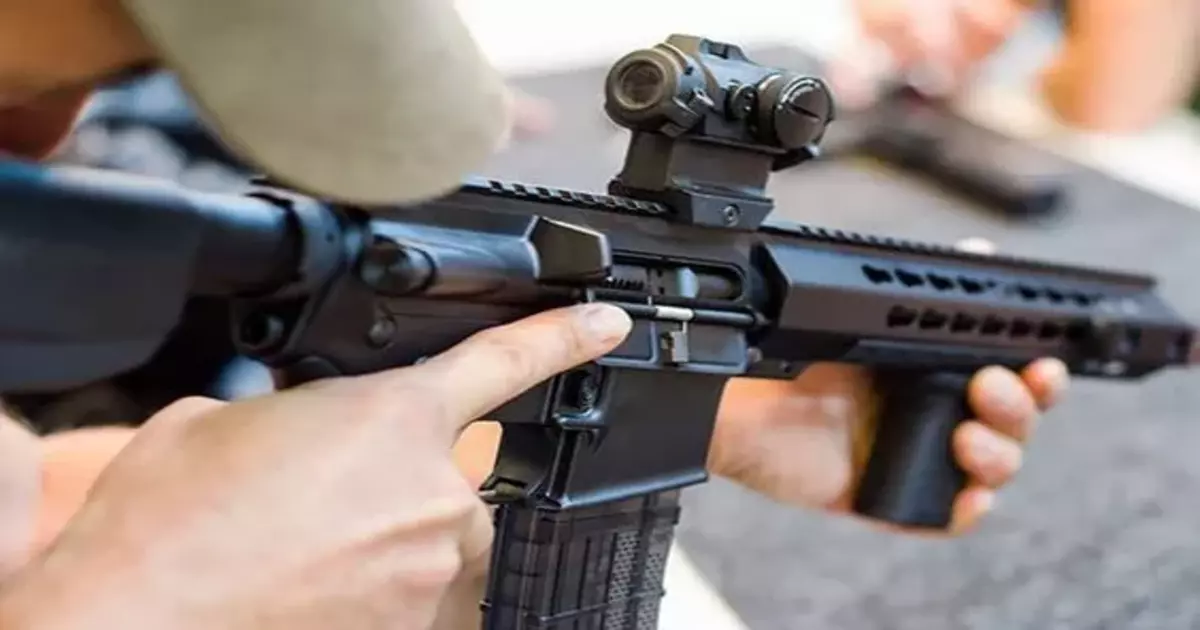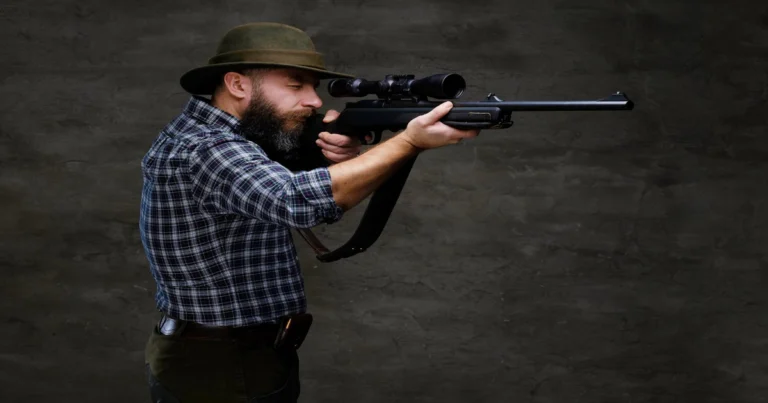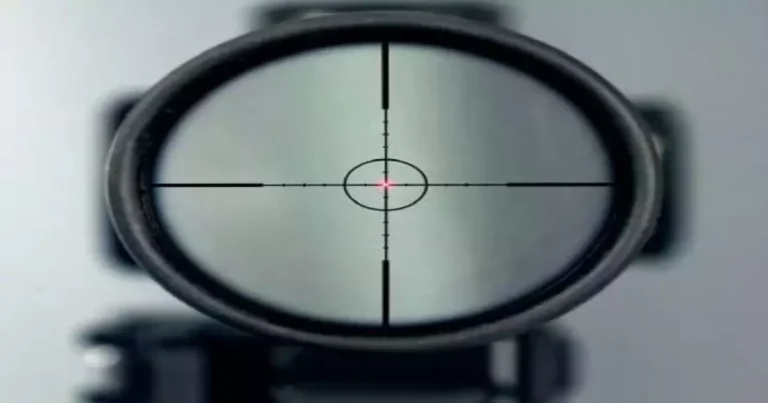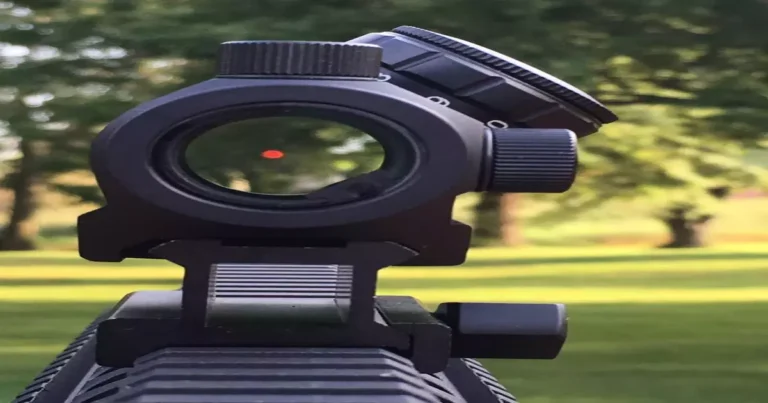The Accuracy and Range of Red Dot Sights Demystified
Red dot sights present a groundbreaking leap in firearm optics, diverging from conventional iron sights or magnified scopes. Utilizing a non-magnifying reflector or reflex sight, they offer an illuminated aiming point projected onto a lens—commonly red or occasionally green—to aid shooters in precision aiming. This superimposed dot facilitates swift target acquisition and precise aiming, enhancing the accuracy and range of red dot sights.
How They Work
Red dot sights operate on a simple principle. They use an LED (Light Emitting Diode) to project the reticle onto a coated glass lens. This lens reflects the light back to the shooter’s eye, appearing as a crisp, red dot. This design ensures that the dot remains parallel to the shooter’s line of sight, regardless of eye position, allowing for quick and accurate aiming.
Growing Popularity in Firearms
In recent years, red dot sights have surged in popularity across various firearm platforms, including handguns, rifles, shotguns, and even crossbows. This rise is due to their versatility and advantages over traditional iron sights or scopes. Their ability to offer rapid target acquisition, especially in close-quarter scenarios, has made them a favorite among shooting enthusiasts, law enforcement, and military personnel.
Advantages Fueling Popularity
- Quick Target Acquisition: Red dot sights allow shooters to acquire targets faster than traditional sights.
- Both-Eye-Open Shooting: Unlike scopes that require a shooter to close one eye, red dot sights permit shooting with both eyes open, enhancing situational awareness.
- Versatility: They perform well in various lighting conditions, including low-light settings, thanks to adjustable brightness settings.
The increasing use of red dot sights in competitive shooting and tactical applications further underscores their rising significance in the firearms community.

Understanding Red Dot Sight Accuracy
How Accuracy is Measured
Accurate shooting with a red dot sight relies on several factors. The primary measure of accuracy involves the ability of the sight to consistently place shots on target in relation to the aiming point. This accuracy is typically evaluated in MOA (Minutes of Angle), representing the angular measurement of deviation at a specific distance.
Assessing Accuracy:
MOA Rating: Red dot sights often come with a stated MOA rating, indicating the size of the dot and its degree of sub tension at a certain distance. For instance, a 2 MOA red dot means the dot will cover a 2-inch diameter at 100 yards.
Consistency: Accuracy is also determined by the sight’s ability to maintain zero and consistently return shots to the same point of aim.
Factors Influencing Accuracy
Accurate performance with a red dot sight is influenced by several key factors:
1. Reticle Types
- Dot Size: Smaller dots provide better precision for longer distances, while larger dots are quicker to acquire for close-range shooting.
- Shape Variations: Some sights offer reticles with different shapes (e.g., dots, circles, or even complex designs). The choice depends on personal preference and use-case scenarios.
2. Quality of Optics
- Lens Clarity: High-quality lenses reduce distortion and offer a clearer, crisper sight picture, enhancing accuracy.
- Coatings: Anti-reflective coatings on lenses improve light transmission and reduce glare, aiding accuracy in various lighting conditions.
3. Mounting and Zeroing Procedures
- Mounting Stability: Properly mounting the sight ensures stability, preventing shifts that could affect accuracy.
- Zeroing: Correctly zeroing the sight at a specific distance is crucial for accuracy. This process involves aligning the point of aim with the point of impact.
Importance of Zeroing:
Red dot sights must be zeroed at a specific distance (commonly 25 or 50 yards for rifles) to ensure that the dot aligns with the bullet’s impact point. The chosen zeroing distance affects the holdover and trajectory at different ranges.
Answering Queries on Accuracy
1. “How accurate is a red dot sight?”
The accuracy of a red dot sight is impressive within its intended range. Typically, a well-zeroed red dot sight can achieve minute-of-angle precision. This means that at 100 yards, a 1 MOA red dot should theoretically cover a 1-inch diameter circle on the target. However, the practical accuracy also depends on the shooter’s skill, consistency, and the specific red dot sight model.
2. “How far are red dot sights accurate?”
Red dot sights maintain their effectiveness within specific ranges. While they excel in short to medium-range engagements, their accuracy may diminish at longer distances. Generally, red dot sights are effective up to around 100 to 300 yards, depending on the sight’s quality, dot size, and the shooter’s proficiency.
3. “What distance is a red dot sight good for?”
The optimal distance for a red dot sight varies based on factors such as dot size, zeroing distance, and the shooter’s preference. Red dot sights are excellent for close-quarters combat (CQB) scenarios, offering quick target acquisition within 0 to 100 yards. Some shooters zero their red dot sights at 50 yards for a balance between close-range and mid-range accuracy.
Considerations for Range:
- Dot Size: Smaller dots are more suitable for longer ranges as they cover less of the target, allowing for more precise aiming.
- Zeroing Distance: Zeroing the sight at different distances can extend its effective range. However, the holdover might become a factor beyond the zeroed distance.
While red dot sights offer remarkable accuracy within their effective range, their optimal distance and precision depend on multiple factors. Understanding these considerations helps shooters leverage the sight’s strengths and maximize accuracy for various shooting scenarios.
Exploring Red Dot Sight Range
Determining Effective Range
Determining the effective range of a red dot sight involves considering various factors that impact its performance at different distances.
1. Magnification and Sight Design:
- Non-Magnified Design: Red dot sights are non-magnified optics, typically offering 1x magnification, meaning they don’t magnify the target. This design is advantageous for maintaining situational awareness and fast target acquisition at closer ranges.
- Limitations at Longer Ranges: Due to the lack of magnification, red dot sights may have limitations when shooting at longer distances compared to magnified scopes. However, with practice and understanding of holdover, shooters can still engage targets effectively.
2. Target Size and Clarity:
- Target Size Consideration: The size of the aiming point (the red dot) in relation to the target becomes a crucial factor at longer ranges. Smaller targets may be harder to hit accurately using a red dot sight due to the dot covering a larger area relative to the target.
- Clarity and Sight Picture: Red dot sights with high-quality lenses and coatings offer better clarity, allowing shooters to maintain a clear sight picture at longer ranges. This enhances the ability to place accurate shots on smaller targets.
3. Distance and Practical Limitations:
- Effective Range: Red dot sights are generally effective up to a few hundred yards, but their practical range might vary based on individual skill, sight quality, and target size.
- Skill and Training: Proficient shooters can effectively engage targets beyond the sight’s theoretical effective range by compensating for bullet drop and utilizing proper aiming techniques.
Realistic Expectations:
Understanding the limitations and strengths of red dot sights helps set realistic expectations. While they might technically function at longer ranges, their optimal effectiveness lies within shorter to mid-range engagements.
Factors Affecting Range
1. Magnification and Sight Design
- Non-Magnified Optics: Red dot sights are designed without magnification, offering a 1x magnification factor. This design maintains a true view of the target without magnifying it, enabling both-eyes-open shooting for increased situational awareness and rapid target acquisition in close to mid-range scenarios.
- Limitations without Magnification: At longer distances, the absence of magnification can limit the shooter’s ability to precisely aim at smaller targets. Without magnification to zoom in on distant targets, the red dot covers a larger portion of the target, making it challenging to achieve pinpoint accuracy.
- Versatility in Engagement: Despite the lack of magnification, red dot sights offer versatility. They excel in scenarios requiring quick target acquisition, making them highly suitable for dynamic shooting situations, such as competitions or tactical encounters within their effective range.
2. Target Size and Clarity
- Impact of Target Size: Red dot sights perform optimally when engaging larger targets at longer distances. Larger targets offer a more substantial aiming surface, allowing shooters to place shots accurately within the red dot’s reticle.
- Clarity and Sight Picture: Higher-quality red dot sights equipped with premium lenses and coatings enhance clarity. This clarity is crucial for maintaining a clear sight picture when aiming at targets at extended ranges. Clearer optics aid in distinguishing finer details of the target, enabling more accurate shot placement.
- Consideration of Reticle Size: The size of the red dot or reticle plays a vital role in target engagement. Smaller dots or reticles allow for more precise aiming at distant targets, as they cover less of the target compared to larger reticles.
Addressing Range-Related Questions
1. “How far can a red dot sight work?”
The effective range of a red dot sight depends on various factors, including the sight’s quality, the shooter’s skill, and the size of the target. Generally, red dot sights are most effective within 0 to 300 yards for rifles and 0 to 100 yards for handguns and shotguns.
- Rifle Applications: Red dot sights mounted on rifles can often reach out to longer distances, sometimes up to 300 yards, for larger targets. However, precision diminishes beyond this range due to the non-magnified nature of the sight.
- Handgun and Shotgun Usage: For handguns and shotguns, red dot sights excel in close-quarters engagements, typically up to 100 yards. Their primary advantage lies in rapid target acquisition and ease of use at shorter distances.
2. “How far is a red dot sight accurate?”
The accuracy of a red dot sight is typically consistent within its effective range. Within this range, which varies depending on factors like dot size, zeroing distance, and shooter proficiency, red dot sights can deliver accurate shots on target.
- Accuracy Limitations: As the distance increases, the red dot covers more of the target, impacting precise shot placement. Beyond the effective range, accuracy diminishes due to bullet drop and the increased sub tension of the red dot on the target.
3. “What is the effective range of a red dot sight?”
The effective range of a red dot sight encompasses the distance at which it can reliably and consistently engage targets while allowing for accurate shot placement. This range typically spans from close-quarters distances up to a few hundred yards, varying based on factors previously mentioned.
- Factors Influencing Effective Range: Factors such as target size, dot size, sight quality, and shooter proficiency collectively determine the red dot sight’s effective range.
Red dot sights offer excellent performance within their effective range, providing shooters with rapid target acquisition and accurate shooting. Understanding the limitations and strengths of red dot sights at different distances helps shooters optimize their use for various shooting scenarios.
Zeroing and Sight-in Distance
Importance of Proper Zeroing
Properly zeroing a red dot sight is a critical step that significantly impacts its accuracy and effectiveness in various shooting scenarios. It involves aligning the point of aim (where the dot is centered) with the point of impact (where the bullet strikes the target) at a specific distance.
1. Precision and Consistency:
- Achieving Accuracy: Zeroing ensures that the red dot’s aiming point corresponds precisely to the bullet’s impact point at the chosen distance. This alignment is crucial for consistent and accurate shot placement.
- Consistency Across Distances: While red dot sights are mainly used within a specific range, proper zeroing allows shooters to maintain a consistent point of impact at different distances within the sight’s effective range.
2. Factors Influencing Zeroing:
- Choice of Zeroing Distance: The selected zeroing distance varies based on shooter preference, firearm type, and intended use. Common zeroing distances for rifles often include 25 or 50 yards, while handguns might use closer distances.
- Environmental Factors: Zeroing should ideally occur in similar conditions to those expected during use, considering factors like wind, lighting, and temperature, to ensure accuracy under realistic circumstances.
3. Enhanced Shooting Performance:
- Improved Confidence: A properly zeroed red dot sight instills confidence in shooters, allowing them to trust the sight’s accuracy and perform consistently during engagements.
- Optimal Usage: Correct zeroing enables shooters to make precise adjustments for elevation and windage, compensating for bullet drop and ensuring accurate shots on target.
Optimal Sight-in Distances
1. Factors Influencing Sight-in Distance
- Firearm Type and Intended Use: The choice of sight-in distance for a red dot sight varies depending on the firearm platform and its intended application. For rifles used in hunting or competition, a sight-in distance of 50 to 100 yards is common, providing versatility for mid-range engagements.
- Close-Quarter Scenarios: In tactical or close-quarter situations, sight-in distances of 25 yards or even closer might be preferred for handguns or rifles. This proximity allows for quick target acquisition in confined spaces.
- Bullet Trajectory Consideration: The selected sight-in distance accounts for the bullet trajectory’s arc at different ranges. Understanding this trajectory aids in compensating for bullet drop and adjusting aim for accurate shots.
2. Recommended Sight-in Procedures
- Initial Alignment: To begin the sight-in process, start by securely mounting the red dot sight on the firearm and ensuring it is properly aligned with the bore.
- Choosing the Distance: Select the sight-in distance based on the factors mentioned earlier. For example, for rifles, 50 yards is often a good starting point for a balance between shorter and longer-range engagements.
- Firing and Adjustments: Fire a series of shots at the chosen distance while aiming at a precise point on the target. Evaluate the shot group and make necessary adjustments to align the point of aim with the point of impact using the sight’s adjustment dials for windage and elevation.
- Confirming Zero: After adjustments, confirm the zero by firing additional rounds. The goal is to achieve consistent shot placement around the point of aim.
- Fine-Tuning and Practice: Fine-tune the zero as needed and practice shooting at various distances within the effective range to ensure confidence in the zeroed sight.
Answers to Common Queries
1. “How far to sight in a red dot?”
The ideal distance to sight in a red dot sight depends on various factors, including the firearm type, intended use, and the shooter’s preferences. Common distances for sighting in red dot sights include 25 yards, 50 yards, and 100 yards.
- Rifle Sight-In Distances: For rifles, the choice of sight-in distance often varies between 50 and 100 yards. Selecting 50 yards as a starting point allows for a balance between shorter and longer-range engagements. Shooters intending to engage targets at greater distances might opt for a 100-yard sight-in.
- Handgun and Close-Quarter Scenarios: In close-quarter scenarios or with handguns, a sight-in distance of 25 yards or even closer might be preferred. This closer distance ensures quick target acquisition and accuracy in confined spaces typical of handgun engagements.
2. “What distance should you sight in a red dot?”
The specific distance for sighting in a red dot sight depends on the shooter’s intended use and the firearm’s application:
- Versatility Consideration: If the goal is versatility across different shooting scenarios, choosing a sight-in distance of 50 yards for rifles provides a balanced approach for mid-range engagements.
- Application Specifics: Tailoring the sight-in distance to the specific application is crucial. For example, hunters may prefer a sight-in distance that aligns with the typical shooting range for their game, while competitive shooters might opt for distances that suit their competition rules and shooting style.
- Personal Preference: Ultimately, the sight-in distance for a red dot sight is a matter of personal preference, influenced by the shooter’s comfort, experience, and the intended range of engagements.
Determining the sight-in distance for a red dot sight involves considering factors such as firearm type, intended use, and personal shooting preferences. Whether it’s 25, 50, or 100 yards, the chosen sight-in distance should cater to the shooter’s needs and align with the firearm’s intended application.
Evaluating Red Dot Sight Costs
Price Range of Red Dot Sights
Red dot sights come in a wide price spectrum, offering options suitable for various budgets and preferences. The cost of red dot sights can vary from as low as $50 to well over $1000, depending on several factors:
1. Entry-Level Red Dot Sights ($50 – $200)
- Basic Features: Entry-level red dot sights within this price range offer fundamental functionalities, often suitable for beginners or recreational shooters.
- Simple Construction: These sights may have simpler constructions, with basic adjustment dials, limited reticle options, and may lack certain advanced features found in higher-priced models.
- Durability and Quality: While they may lack the premium build quality of higher-priced options, some entry-level red dot sights still offer decent durability and performance for casual shooting activities.
2. Mid-Range Red Dot Sights ($200 – $600)
- Enhanced Features: Red dot sights in this price range often offer a balance between affordability and advanced features.
- Improved Optics: They may feature improved lens quality, coatings for better light transmission, and more precise adjustments for windage and elevation.
- Versatility and Durability: Mid-range sights might offer increased versatility, with multiple reticle options, adjustable brightness settings, and better construction quality for enhanced durability.
3. High-End Red Dot Sights ($600 – $1000+)
- Advanced Features: High-end red dot sights come with cutting-edge technology, providing superior performance and precision.
- Premium Optics: These sights feature top-tier optics, high-quality construction materials, advanced reticle options, and often incorporate additional features like motion sensors, long battery life, or compatibility with night vision devices.
- Professional-Grade: Often preferred by competitive shooters, law enforcement, or military personnel due to their exceptional durability, reliability, and performance under various conditions.
The price range of red dot sights caters to a wide spectrum of users, offering options from budget-friendly models suitable for beginners to professional-grade optics used by experts. When choosing a red dot sight, balancing features, build quality, and intended use against the budget ensures finding the right optic that meets individual shooting needs.
Factors Impacting Price
1. Quality of Optics and Build Materials
- Optical Quality: The quality of lenses and coatings significantly affects the price of red dot sights. Higher-priced optics often feature premium lenses with superior clarity, reduced distortion, and better light transmission. Coatings that minimize glare and enhance contrast contribute to better optical performance.
- Build Materials: Red dot sights come in various construction materials, affecting their durability and weight. High-end models use aircraft-grade aluminum or even titanium for superior strength and lightweight design. Robust build materials contribute to increased durability, impact resistance, and overall quality but may escalate the price.
- Ruggedness and Weather Resistance: Higher-priced red dot sights often offer better resistance to water, fog, and shock. These durable features ensure reliability in harsh environmental conditions and prolonged use, contributing to their higher price tag.
2. Additional Features and Brands
- Advanced Features: Red dot sights with additional features, such as multiple reticle options, adjustable brightness settings, motion activation, solar power, or compatibility with night vision devices, tend to be pricier. These added functionalities enhance versatility but come at a higher cost.
- Brand Reputation: Established and reputable brands in the optics industry often command higher prices. These brands invest in research, development, and quality control, ensuring their products meet stringent standards. The reputation for reliability and performance contributes to the higher price of their products.
- Specialized Applications: Some red dot sights cater to specific shooting applications, such as competitive shooting, tactical use, or hunting. Sights designed for specialized uses with unique features or technology may come at a premium due to their targeted functionality.
“How much is a red dot sight?”
The cost of a red dot sight varies significantly based on several factors, including its quality, features, brand, and intended use. Red dot sights come in a broad price range, catering to different budgets and preferences. Here’s an overview of the typical price ranges you can expect:
- Entry-Level Red Dot Sights ($50 – $200): Basic red dot sights within this range offer fundamental functionalities suitable for beginners or recreational shooters. They might lack advanced features but serve adequately for casual shooting.
- Mid-Range Red Dot Sights ($200 – $600): These sights strike a balance between affordability and advanced features. They offer improved optics, durability, and more advanced functionalities compared to entry-level models.
- High-End Red Dot Sights ($600 – $1000+): High-end red dot sights come with top-tier optics, exceptional build quality, and advanced features. Preferred by professionals, competitive shooters, and enthusiasts, they offer superior performance and durability but come at a higher cost.
The specific price within these ranges depends on various factors such as:
- Brand Reputation: Established brands with a strong reputation in the optics industry tend to offer products at a higher price due to their commitment to quality and performance.
- Optical Quality and Build Materials: Higher-priced red dot sights often feature better optical clarity, premium lenses, durable construction with high-grade materials like aircraft-grade aluminum, and enhanced weather-resistant properties.
- Additional Features: Sights with added functionalities such as multiple reticle options, adjustable brightness settings, motion sensors, or compatibility with night vision devices usually come at a premium.
The price of a red dot sight varies based on its quality, features, brand, and intended application. Understanding the different price ranges and the factors that influence the cost helps shooters choose a red dot sight that aligns with their budget and shooting requirements.
Practical Applications of Red Dot Sights
1. Tactical Use
- Close-Quarters Battle (CQB): Red dot sights excel in CQB scenarios, offering rapid target acquisition and both-eyes-open shooting, crucial for tactical operations in confined spaces.
- Enhanced Situational Awareness: They provide improved situational awareness, allowing shooters to maintain focus on the target and surroundings simultaneously.
2. Hunting
- Quick Target Acquisition: Red dot sights aid hunters in quickly acquiring targets, especially in dense foliage or low-light conditions, enhancing hunting efficiency.
- Adaptability: These sights are versatile and suitable for various hunting applications, offering ease of use in dynamic environments.
3. Competitive Shooting
- Precision and Speed: Red dot sights are favored in competitive shooting disciplines for their combination of accuracy and rapid target engagement, contributing to better scores and faster times.
- Customization and Adjustability: Many models offer adjustable settings, allowing competitors to fine-tune the sight to their preferences and shooting style.
Conclusion
Within the dynamic realm of firearm optics, red dot sights epitomize innovation and flexibility. These compact yet potent aiming tools have revolutionized target engagement, providing a fusion of speed, versatility, and precision to shooters across varied scenarios, enhancing the accuracy and range of red dot sights.
From their inception as a tool for rapid target acquisition in tactical environments to becoming a staple in hunting escapades and competitive shooting circuits, red dot sights have redefined the art of aiming. Their ability to facilitate both-eyes-open shooting, enhancing situational awareness, has become a hallmark feature in dynamic engagements.
The advantages of red dot sights—quick target acquisition, ease of use, and consistent accuracy—have reverberated throughout the firearms community. These optics have empowered shooters, providing them with a reliable and efficient tool that balances precision with rapid target engagement, contributing to improved performance in various disciplines.
What sets red dot sights apart is their adaptability to different firearms and applications. Whether navigating close-quarters situations, stalking game in dense woods, or competing on the firing line, these sights offer a versatile solution, enhancing the shooter’s capabilities across the spectrum.
As technology advances and preferences evolve, red dot sights continue to evolve, incorporating innovative features and refining their performance. Their presence in the firearms realm remains indispensable, offering shooters a reliable and efficient aiming solution that stands at the forefront of aiming technology.
In the journey towards precision and efficiency, red dot sights remain steadfast companions, enabling shooters to hone their skills, enhance their performance, and embrace the future of firearm optics.



